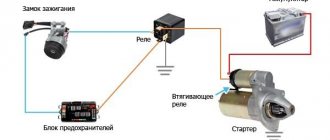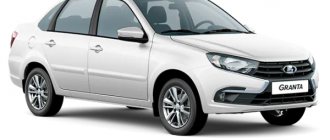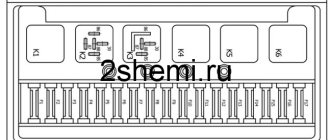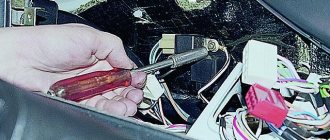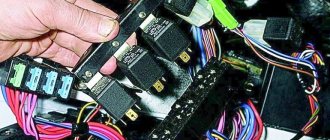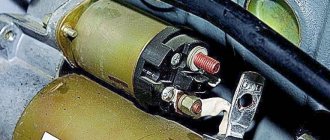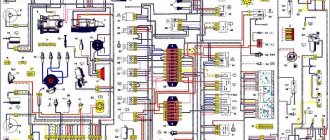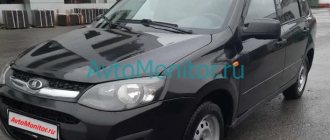Kalina » Maintenance and repair
A possible cause of non-working power windows, cigarette lighter or other electrical appliance may be a blown fuse or broken relay.
Below - about fuses and relays on the LADA Kalina (station wagon, hatchback) of the 2nd generation: where they are, how the circuits are deciphered and how to replace them yourself.
Block in the engine compartment
The engine compartment fuse box on LADA Kalina 2 is fixed near the positive terminal of the battery.
Location
Location diagrams and decoding are given in the tables below.
For cars assembled in 2013-2016
| No. on the diagram | Denomination, A | Protected Circuits |
| 1 | 50 | Heated windshield |
| 2 | 60 | Generator |
| 3 | 60 | Generator |
| 4 | 30 | Cooling system fan (versions without climate control or air conditioning) |
| 4 | 40 | Cooling fan |
| 5 | 50 | Electromechanical power steering |
| 6 | 40 | ABS |
For cars assembled in 2022, 2022
| No. on the diagram | Denomination, A | Protected Circuits |
| 1 | 60 | Generator |
| 2 | 60 | Generator |
| 3 | 30 | Cooling fan (in configurations without climate control or air conditioning) |
| 3 | 40 | Cooling fan |
| 4 | 40 | ABS/ESC |
| 5 | 25 | ABS/ESC |
| 6 | 50 | Electric power steering |
Troubleshooting pumps
Now let's move on to consider the situation when the reason lies directly in the fuel pump itself. Replacing a unit is a drastic measure that can be avoided in almost the vast majority of cases.
Read more: Replacing glass on a Skoda Octavia A5
Scheme
- To check the LADA Kalina pump, you will need to dismantle it.
- Access to the device location is provided through the rear of the cabin. To do this, you will need to remove the rear seat cushion.
- The pump module is closed with a special cover; when removing it, you will need to remove the fixing fasteners.
- When the ignition is turned on, the pump may not pump at all or supply fuel intermittently. If this is present, the device requires maintenance or replacement.
- The further dismantling process involves removing the cover and disconnecting the pipes.
- Now you can unscrew the locking ring, after which you need to carefully remove the pump from the cavity of the fuel tank.
- We carefully inspect the dismantled unit for clogging of the filter present in its module, which is made in the form of a mesh. If it is not very clogged, then it can be washed, but when there are breaks and a high degree of contamination, then no alternative replacement is required.
This type of routine maintenance is not covered by the Lada Kalina operational manual. Despite this, the mesh on the pump should be replaced every 50 thousand km of the distance traveled. Such experience has the right to life due to the insufficient quality of domestic fuel.
Determining the need to replace the pump filter component is not difficult. As noted, this is done through visual inspection. Usually the mesh contains a dirty-brown mixture, which includes metal particles and other debris. The bottom of the pump assembly cup is often littered with solid particles of various natures.
Regarding the previously mentioned possibility of washing the mesh, many experts have a negative attitude towards this practice. Compared to the labor costs of dismantling the pump, the cost of the mesh itself is quite insignificant - about 100 rubles. It would be more rational and correct, in our opinion, to replace it, the main thing is to know where it is.
Block in the cabin
The interior fuse box is installed in the instrument panel between the steering wheel and the external lighting control knobs and is covered with a decorative panel.
Location
Appearance (example)
The diagram and assignment of fuses are given in the tables below.
For cars produced in 2013-2015
In cars produced in 2013-2015, two mounting blocks were used: Delphi and 1118-3722010-00. The cigarette lighter fuse is designated F18.
Delphi mounting block
Mounting block 1118-3722010-00
Circuit breakers
| No. on the diagram | Denomination, A | Protected Circuits |
| F1 | 15 | Ignition coils; Injectors; ECU; Cooling fan |
| F2 | 5(1) | Daytime Running Lights |
| 25(2) | Central body electronics unit, driver's door module | |
| F3 | 10(1) | Alarm |
| 15(2) | ECU and automatic transmission drive | |
| F4 | 15 | Airbags |
| F5 | 7.5 | Instrument terminal 15 (instrument cluster, engine control system controller, body electronics module, electromechanical power steering, brake pedal switch, speed sensor, automatic transmission selector, windshield wiper switch, rear window defroster switch relay, heated windshield relay ( No. 1, No. 2), seat heating relay, unloading relay) |
| F6 | 7.5(1) | Reversing lamps, direction indicators |
| 7.5(2) | Reversing lamps; Automatic transmission ECU; Parking Assist ECU | |
| F7 | 7.5 | Canister purge valve; Sensors: mass air flow/pressure, phases, oxygen concentration |
| F8 | 25(2) | Heated exterior mirrors and rear window |
| F9 | 5 | Side lights on the right side |
| F10 | 5 | Side lights on the left side; Illumination of instruments and keys; License plate lights; Luggage and glove box lighting |
| F11 | 5 | Rear fog lights |
| F12 | 10 | Low beam (right headlight), electric corrector of the right headlight |
| F13 | 10 | Low beam (left headlight), electric corrector of the left headlight |
| F14 | 10 | High beam (right headlight) |
| F15 | 10 | High beam (left headlight) |
| F16 | 10(2) | Right fog lamp |
| F17 | 10(2) | Left fog lamp |
| F18 | 15(1) | Cigarette lighter |
| 20(2) | Cigarette lighter, heated front seats | |
| 10(2) | Cigarette lighter | |
| F19 | 20(1) | central locking |
| 7.5(2) | ABS ECU | |
| 5(2) | ABS ECU | |
| F20 | 15 | Sound signal |
| F21 | 10 | Fuel pump |
| F22 | 15(1) | Front wiper and washer; Rear wiper and washer |
| 25(2) | Central body electronics unit; Windshield washer; Rear window washer and wiper; | |
| F23 | 5 | Instrument cluster; Diagnostic connector |
| F24 | 7.5(2) | Air conditioning compressor clutch; Automatic climate control computer |
| F25 | 7.5(1) | Brake lamps; Interior lighting |
| F26 | 25(2) | Electronic anti-lock brake valves |
| 10(2) | Central body electronics unit | |
| Delphi mounting block | ||
| F27 | 25(2) | Electronic anti-lock brake valves |
| F28 | 30(1) | Heater |
| 30(2) | Heater; Automatic climate control computer | |
| Mounting block 1118-3722010-00 | ||
| F31 | 30(1) | Front door windows |
| 30(2) | Central body electronics unit; Brief inclusion of high beams; Wiper motor | |
| 25(2) | Electronic anti-lock brake valves | |
| F32 | 30(1) | Heater |
| 30 | Heater; Automatic climate control computer | |
Relay
| No. on the diagram | Protected Circuits |
| K1 | Cooling fan |
| K2 | Window lifters(1) |
| Cooling fan(2) | |
| K3 | Starter |
| K4 | Ignition switch unloading relay |
| K5 | Hazard and direction indicators(1) |
| K6 | Windshield wiper(1) |
| Heated front seats(2) | |
| K7 | High beam |
| K8 | Sound signal |
| K9 | Low beam |
| K10 | Heated rear window(1) |
| Heated rear window and exterior mirrors(2) | |
| K11 | Engine control unit (main relay) |
| K12 | Fuel pump |
| K13 | Hazard alarm(1) |
| Reversing lamps(2) | |
| K14 | Hazard alarm(1) |
| Cooling fan(2) | |
| K15 | Heated windshield(2) |
| K16 | Heated windshield(2) |
| K17 | A/C compressor clutch(2) |
Note to the table:
- (1) – “Standard” package;
- (2) – “Norma”, “Lux” configurations.
For cars produced in 2015, 2016
Circuit breakers
| No. on the diagram | Denomination, A | Protected Circuits |
| F1 | 15 | Ignition coils; Injectors; ECU |
| F2 | 30 (2) | Central body electronics unit; Driver door module |
| F2 | 10(1) | Daytime Running Lights |
| F3 | 10(1) | Alarm |
| 15(2) | ECU and automatic transmission drive | |
| F4 | 15 | Airbags |
| F5 | 7.5 | Instrument terminal 15 (starter relay, automatic transmission controller, ignition switch unloader relay, heated rear window relay, heated seat relay, heated windshield relay, fuel pump relay, ECM, audio system, electric power steering, wiper switch, central body electronics unit, "ERA-GLONASS", clutch pedal switch (manual transmission), brake pedal switch, instrument cluster, door lock, driver's door lock switch, air conditioning switch, automatic transmission speed sensor, automatic transmission mode switch, automated transmission controller (AMT) , tire pressure monitoring) |
| F6 | 7.5 | Reversing lamps; Automatic transmission ECU(2) |
| F7 | 7.5 | Canister purge valve; Mass air flow sensor (engines 11186 and 21126); Pressure sensor (engine 21127); Phase sensor (motors 21126, 21127); Oxygen concentration sensors |
| F8 | 7.5(1) | Direction indicators |
| F9 | 5 | Side lights on the right side |
| F10 | 5 | Side lights on the left side, illumination of instruments and keys; License plate lights; Trunk light; Glove box light |
| F11 | 5 | Rear fog lights |
| F12 | 10 | Low beam (right headlight); Electrical corrector for right headlight |
| F13 | 10 | Low beam (left headlight); Left headlight electric corrector |
| F14 | 20 | Cleaner, windshield washer; Steering column wiper switch; Central body electronics unit (windshield wiper (optional)) |
| F15 | 10 | Cleaner, rear window washer |
| F16 | 5(2) | Driver door module |
| F17 | – | Reserve (not used) |
| F18 | – | Reserve (not used) |
| F19 | 20(1) | central locking |
| F20 | – | Reserve (not used) |
| F21 | 10 | High beam (right headlight) |
| F22 | 10 | High beam (left headlight) |
| F23 | 10(2) | Right fog lamp |
| F24 | 10(2) | Left fog lamp |
| F25 | 15 | Heated front seats |
| F26 | 5 | ABS ECU |
| F27 | 15 | Cigarette lighter |
| F28 | 15 | Fuel pump |
| F29 | 20 | Central body electronics unit(2); Cleaner, windshield washer |
| F30 | – | Reserve (not used) |
| F31 | 7,5(2) | Air conditioning compressor clutch; Automatic climate control computer |
| F32 | 7.5 | Brake lamps; Interior lighting |
| F33 | 25 | ABS ECU |
| F34 | 5 | Instrument cluster; Diagnostic connector |
| F35 | 10(2) | Central body electronics unit |
| F36 | 10 | Sound signal |
| F37 | 10 | Audio/Multimedia system |
| F38-F41 | – | Reserve (not used) |
| F42 | 30(1) | Window lifters |
| F43 | 50 | Automatic transmission control unit |
| F44 | 30 | Heater, automatic climate control control unit (optional) |
| F45 | 25 | Rear window defroster |
| F46 | – | Reserve (not used) |
Relay
| No. on the diagram | Protected Circuits |
| K1 | Ignition switch unloading relay |
| K2 | Starter |
| K3 | Windshield wiper(1); Cooling fan(2) |
| K4 | Cooling fan |
| K5 | Direction indicators(1); A/C compressor clutch(2) |
| K6 | Front power windows(1); Heated rear window(2) |
| K7 | High beam |
| K8 | Sound signal |
| K9 | Low beam |
| K10 | Reversing lamps (equipped with AMT)(2) |
| K11 | ECU |
| K12 | Fuel pump |
| K13 | Seat heating |
| K14 | Alarm(1); Heated windshield(2) |
| K15 | Heated rear window(1) |
| K16 | Hazard alarm(1) |
Note to the table:
- (1) – “Standard” package;
- (2) – “Norma”, “Lux” configurations.
For cars 2022, 2022 model year
Circuit breakers
| No. on the diagram | Denomination, A | Protected Circuits |
| F1 | 15 | Ignition coils (16 cells); Injectors; ECU; Cooling fan relay (low speed - with air conditioning or air conditioning); Cooling Fan Relay (High Speed) |
| F2 | 7.5 | Intake pipe flap valve (engine 21127); Canister purge valve; Oxygen sensors; Phase sensor (motors 21126, 21127); Mass air flow sensor (motors 11186, 21126); Automated transmission selector (AMT); Tire pressure monitoring |
| F3 | 5 | ABS/ESC |
| F4 | 15 | Airbags |
| F5 | 7.5 | Instrument terminal 15 (starter relay, automatic transmission controller, ignition switch unloader relay, heated rear window relay, heated seat relay, heated windshield relay, fuel pump relay, ECM, audio system, electric power steering, wiper switch, central body electronics unit, "ERA-GLONASS", clutch pedal switch (manual transmission), brake pedal switch, instrument cluster, door lock, driver's door lock switch, air conditioning switch, automatic transmission speed sensor, automatic transmission mode switch, automated transmission controller (AMT) , tire pressure monitoring) |
| F6 | 7.5 | Reversing lamps; Direction indicators; Parking system ECU |
| F7 | 10 | High beam (right headlight) |
| F8 | 10 | High beam (left headlight) |
| F9 | 5 | Side lights on the right side |
| F10 | 5 | Side lights on the left side; Illumination of instruments and keys; License plate lights; Luggage and glove box lighting |
| F11 | 5 | Rear fog lights |
| F12 | 10 | Low beam (right headlight); Electrical corrector for right headlight |
| F13 | 10 | Low beam (left headlight); Left headlight electric corrector |
| F14 | 20 | Windshield cleaner and washer; Steering column wiper switch; Central body electronics unit: (windshield wiper (optional)) |
| F15 | 10 | Rear window cleaner and washer |
| F16-F20 | – | Reserve (not used) |
| F21 | 15 | Fuel pump |
| F22 | 7.5 | Brake light switch; Brake lamps; Additional brake light; ABS/ESC ECU; Automatic transmission controller |
| F23 | 5 | Instrument cluster; Diagnostic connector |
| F24 | 10 | Sound signal |
| F25 | 15 | Cigarette lighter |
| F26 | 5 | "ERA-GLONASS" |
| F27 | 10 | Right fog lamp |
| F28 | 10 | Left fog lamp |
| F29 | 15 | Heated front seats |
| F30 | 10 | Audio system |
| F31 | 10 | Central body electronics unit - in a variant version (direction indicators, power supply for the body electronics unit) |
| F32 | 30 | Central body electronics unit - in a variant version (window lifters, central locking, rain sensor, glove box light, trunk light, interior light unit, daytime running lights) |
| F33 | 5 | Driver door module |
| F34 | 7.5 | Air conditioning compressor clutch; Automatic climate control computer |
| F35 | 15 | Automatic transmission controller; Automatic transmission control drive |
| F36 | 15 | Alarm |
| F37 | 15 | Central locking (trunk lock switch, door lock) |
| F38 | 10 | Daytime Running Lights |
| F39 | 15 | Cigarette lighter in trunk |
| F40 | 10 | Trailer connector |
| F41 | 50 | Heated windshield |
| F42 | 30 | Heated rear window and exterior mirrors |
| F43 | 50 | Automated Transmission Controller (AMT) |
| F44 | 30 | Heater; ECU for automatic climate control (optional) |
| F45 | 30 | Front windows |
| F46 | — | Reserve (not used) |
Relay
| No. on the diagram | Protected Circuits |
| K1 | Ignition switch unloading relay |
| K2 | Starter |
| K3 | Autostart |
| K4 | Cooling fan (high speed) - (optional) |
| K5 | Hazard and direction indicators(1) |
| K6 | Heated rear window |
| K7 | High beam |
| K8 | Sound signal |
| K9 | Low beam |
| K10 | A/C compressor clutch |
| K11 | ECU |
| K12 | Fuel pump |
| K13 | Seat heating |
| K14 | Heated windshield(2) |
| K15 | Alarm |
| K16 | Alarm; Reversing lamps (in configurations with AMT) |
| K17 | Window lifters; Cooling fan (in autostart mode) |
| K18 | Cooling fan (low speed) - (optional) |
Where are the fuses for Lada Kalina 2?
The fuse box is located near the driver's left foot. Pull the lower left corner of the cover (#1) to release the left locking point, then the middle (#2) and the two right locking points (#3 and 6). Then release the upper locking points (No. 4 and 5) and remove the cover.
Installing the fuse box cover is carried out in the following order: first snap the right fastening elements, then the lower ones, and then the upper ones. Make sure that the fastening elements of the cover are aligned exactly with the metal fasteners.
On the plastic cover of the mounting block there are symbols that indicate what each fuse (F) and relay (K) is responsible for, as well as their numbering.
Removal and replacement process
To replace blown fuses and broken relays, you will need plastic tweezers or needle-nose pliers/long-nose pliers.
Under the hood
The procedure is as follows:
- Turn off the ignition and open the hood.
- Remove the cover from the unit by pulling it up.
- Pull out the required fuse and insert a new one.
- Check the operation of the protected device. If the fuse link immediately burns out, you need to find and eliminate the cause of the short circuit.
- Close the block with a lid.
What is a fuse
Yes, you understood correctly, not all car enthusiasts know even this. Especially those who open the hood in order to be convinced once again that this shaitan-machinery is beyond his understanding.
Fuses are small elements that melt when overloaded, thereby breaking the current circuit. Looking in detail at the Priora fuse box, it is easy to see that they consist of a conductive element, which contains several plates made of different materials. It is between them that the fusible inserts are located.
The fuses themselves are very cheap for the Lada Priora. One of them costs from 25 to 55 rubles.
Capabilities of modern relays
Today, many manufacturers produce modern windshield wiper relays with an adjustable pause on the Chevrolet Niva, VAZ, Lada-Kalina and other types of vehicle models. For each car, certain systems have been developed that allow you to properly adjust the operation of the wipers.
When installing such a device on his vehicle, the driver has the opportunity to adjust the brush strokes at intervals from 0.5 to 45 seconds. This function allows you to select the most comfortable mode that matches the existing weather conditions.
In this case, you can configure not only the movement of the wipers when driving along the highway in bad weather, but also during the glass cleaning mode. If water is supplied to it, the standard control unit will make 4 strokes of the brushes. The last of them will be done on almost dry glass. If there is an adjustable relay, there will be only 3 strokes. This will prevent the rubber elements of the brushes from sliding on a dry surface.
Everything about car windshield wiper blades and wipers
Very often, weather conditions on the road develop in such a way (for example, with light drizzle) that there is a need for intermittent operation of the windshield wiper blades. In such situations, many motorists understand how convenient it is to have a windshield wiper relay with an adjustable pause on their car. Thanks to this design, driving comfort is significantly improved. We will talk about the need for such a relay, how to use it and whether it can be installed on your car if it doesn’t already exist in this article.
Advantages
It is worth ordering a windshield wiper relay with an adjustable pause for several reasons. This re-equipment of the design allows you to get a lot of advantages. The comfortable brush sweep mode allows for good visibility on the road in any weather. Regardless of the intensity of precipitation, cleaning will be carried out in the most suitable mode.
If the pause when flapping the brushes is even 0.5 seconds, this will significantly increase the service life of the wipers and their rubber elements. The frictional force will have less impact on the material. At the same time, in the process of cleaning glass using a jet of water, it will be possible to avoid the movement of the brushes on a dry surface. This also significantly extends the life of the brushes.
At the same time, purchasing an additional relay will not require large financial costs. If you wish, you can install this control unit yourself. This does not require much effort and time. A simple procedure will help increase comfort when driving a car in bad weather.
Relay functions
The windshield wiper relay with an adjustable pause for UAZ, VAZ, Chevrolet, Kia and other car brands differs in functionality and design. It should be noted that the presented part is available in almost every vehicle. However, its functionality is significantly different.
When it rains, snow or other precipitation, their intensity may vary. During heavy rain, it is necessary that the brushes make frequent strokes, providing a clear view of the road. But in drizzling rain or light snow this is not required. The brushes should occasionally remove grains from the windshield.
READ GT 55830 how to connect
If the model of the frequency regulator does not provide for long pauses in movement, this may cause discomfort. Many drivers have encountered a situation where the blades, often moving across the windshield, simply smear the occasional drops of rain. At the same time, divorces remain. They impair visibility. This is an unsafe factor when driving.
Original sizes of brushes on Grant
The length of the driver's windshield wiper is 600 mm. The length of the passenger wiper is 410 mm. Fastening type - “hook” (in English hook).
Foreign manufacturers indicate the length of the windshield wiper in inches, so the suitable length for a passenger blade is 16″. Sixteen inches - 406 mm, probably because of this, brushes with lengths of both 40 and 41 cm can be installed on the right side of the Granta. If desired, you can install a passenger windshield wiper up to 45 cm, but I would recommend staying in the range of 400...410 mm.
I have added brush article numbers to the selection: they will help you find specific products in stores that sell auto parts (this is faster and, most likely, cheaper). Also, the articles will allow you to avoid compromises in the form of several centimeters in the length of the brushes - choose only what is made specifically for your car.
Finally, a comparison of prices for windshield wipers.
Why do you need to adjust pauses?
A regular windshield wiper is usually indispensable in rainy weather, but this is only if the rain is relatively heavy and not light. In drizzling rain, the standard performance of the wiper is not very satisfactory, to put it mildly. I mean those cases when intermittent mode is enabled. It just so happens that every factory wiper has a standard pause between periods of its activity. This pause is usually four seconds. In the event of light rain, the windshield simply does not have time to become wet and, as a result, the brushes pass over a dry surface, which is often irritating and causes the subsequent appearance of streaks.
In this case, you have to get out of it by regularly turning off/on the wipers every twenty seconds. This clearly interferes with driving as the driver becomes more and more irritated over such a seemingly insignificant problem. In general, the complexity of the necessary work to change such a temporary indicator is not very high, which already eliminates the high probability of negative consequences due to intervention on the part of the driver.
conclusions
In our opinion, the ability to adjust the pause between strokes of the windshield wiper blades depending on the driving situation is not just a whim. This directly affects traffic safety. It’s not for nothing that almost all modern cars are equipped with this useful feature. If your car does not have such a relay, we advise you to try to select a ready-made solution from the modified windshield wiper relays offered on the auto parts market with the ability to set the required pause. Everyone who has modified their car in this way is usually satisfied with the result.
Found an inaccuracy in the article? Do you have anything to add? Please write to us about it in the comments.
Standard relays
Standard windshield wiper relays with an adjustable pause for VAZ, UAZ and other car brands have two operating modes. In the first, the brushes swing without pause. This mode is suitable if there is heavy rain. The second mode has a pause between swings. By default it is 4 seconds.
This situation sometimes makes it difficult to select the optimal mode for eliminating drops from the windshield. Many modern car models provide adjustments with the ability to set the time between brush strokes. However, relatively inexpensive vehicle models do not have this option.
In this case, the driver is forced to either put up with this brush flapping mode or turn it on manually. In this case, literally every 20 s. you have to use the windshield wipers and then turn them off again. This allows for normal visibility. However, manually turning on the wipers can distract the driver. This action may lead to an accident. Therefore, it is recommended to retrofit your vehicle with a more modern relay design.
Performing revisions
The windshield wiper relay is modified by installing a new resistor. You will also need about 50 cm of single-core or one double-core wire. It is soldered to the extreme contact of the resistor. The old resistance element must be desoldered on one side only. One wire is soldered to its freed leg, and the second is connected to the place where it was installed before.
The second end must be connected to the central contact. The wires must be covered in a cambric made of transparent material. Next, you need to make a knot on the wires so as not to accidentally tear them off. The relay cover can be closed. The part is mounted in its original place. Having considered what a windshield wiper relay is, every driver will be able to use it for the wipers of his car.

